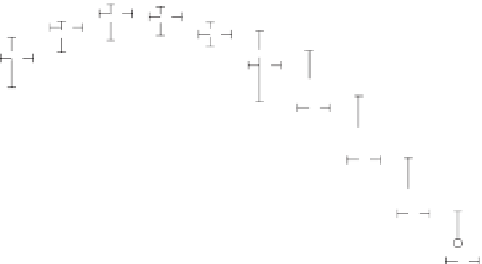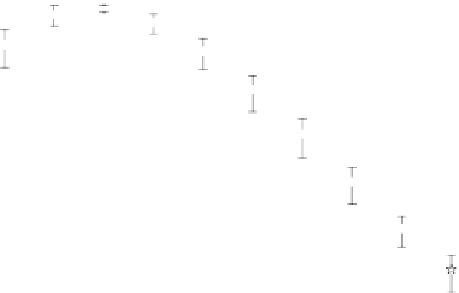Geoscience Reference
In-Depth Information
Fig. 5.1
Mean daily average aerosol size distribution, fine mode (0.05 < radius ≤ 0.6 µm) for (
1
)
Davos for 2010, (
2
) Mauna Loa for 2010, and (
3
) Izana for 2009
for the observed universal characteristics of fractal fluctuations in turbulent at-
mospheric flows. The model predictions are as follows. (i) The apparently cha-
otic (unpredictable) fluctuations can be resolved into a nested continuum of vortex
roll circulations tracing the space filling quasiperiodic Penrose tiling pattern with
an overall logarithmic spiral trajectory. (ii) The amplitude and also the variance
(square of the amplitude) of fractal fluctuations are quantified by the same statisti-
cal probability distribution function incorporating the golden mean τ and exhibits
scale-free universal inverse power law characteristics. Therefore, fractal fluctua-
tions are signatures of quantum-like chaos since square of the eddy amplitudes, i.e.,
variances, represent the probability densities (of amplitudes), a property exhibited
by the subatomic dynamics of quantum systems such as electron or photon. (iii) At-
mospheric particulates are held in suspension in the fractal fluctuations of vertical
wind velocity. The mass or radius (size) distribution for homogeneous suspended
atmospheric particulates is expressed as a universal scale-independent function of
the golden mean τ, the total number concentration, and the mean volume radius.
The universal aerosol size spectrum will have applications in computation of radia-
tion balance of earth-atmosphere system in climate models.
Model predictions are in agreement separately, with the fine (0.1-0.6 µm) and the
coarse (0.6-15 µm) mode AERONET aerosol inversion data sets (daily averages)
















































































































































Search WWH ::

Custom Search